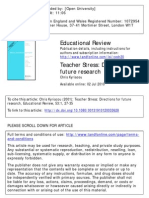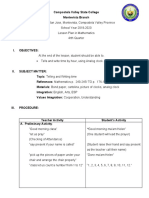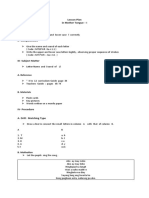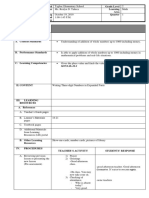1
Jski.dv
GRADE 1 to 12
DAILY LESSON LOG
School
TUBIGON EAST CENTRAL ELEM SCHOOL
Grade Level
I-ROSE
Teacher
EMMA R. MULAT
Learning Area
Mathematics
Teaching Dates and Time
Dec. 5-9, 1:30-2:20
Quarter/Week
THIRD/Week 25
MONDAY TUESDAY WEDNESDAY THURSDAY FRIDAY
I.
OBJECTIVES
Objectives must be met over the week and connected to the curriculum standards. To meet the objectives necessary procedures must be followed and if needed, additional lessons, exercises, and remedial activities may be done for developing content knowledge and competencies. These are assessed using Formative Assessment strategies. Valuing objectives support the learning of content and competencies and enable children to find significance and joy in learning the lessons. Weekly objectives shall be derived from the curriculum guides.
A.
Content Standard
The learner demonstrates understanding of 2-dimensional and 3-dimensional figures.
B.
Performance Standard
The learner is able to describe, compare, and construct 2-dimensional and 3-dimensional objects.
C.
Learning Competency/Objectives
Write the LC code for each.
M1GE-IIIe-1.1
Identify the four basic shapes.
M1GE-IIIe-1.2
Identify, describe and draw the four basic shapes in 2-dimensional and 3-dimensional objects: square and rectangle
M1GE-IIIe-1.3
Identify, describe and draw the four basic shapes in 2-dimensional and 3-dimensional objects: triangle and circle
M1GE-IIIe-2.1
Compares and classifies 2-dimensional objects (flat/plane) figures according to common attributes
M1GE-IIIe-2.1
Compares and classifies 3-dimensional objects (solid) figures according to common attributes
II.
CONTENT
Content is what the lesson is all about. It pertains to the subject matter that the teacher aims to teach in the CG, the content can be tackled in a week or two.
Geometry
III.
LEARNING RESOURCES
A.
References 1.
Teacher’s Guide pages
K-12 Curriculum Guide p. 14
Mathematics I Teacher’s Guide pp.
36-40 K-12 Curriculum Guide p. 14
Mathematics I Teacher’s Guide pp.
36-40 K-12 Curriculum Guide p. 14
Mathematics I Teacher’s Guide pp.
36-40 K-12 Curriculum Guide p. 14
Mathematics I Teacher’s Guide pp.
36-40 K-12 Curriculum Guide p. 14
Mathematics I Teacher’s Guide
pp. 36-40 2.
Learner’s Materials pages
79 87 3.
Textbook pages 4.
Additional Materials from Learning Resource (LR)portal B.
Other Learning Resource Shapes Real objects Shapes Real objects Shapes Real objects Shapes Real objects Shapes Real objects
IV.
PROCEDURES
These steps should be done across the week. Spread out the activities appropriately so that students will learn well. Always be guided by demonstration of learning by the students which you can infer from formative assessment activities. Sustain learning systematically by providing students with multiple ways to learn new things, practice their learning, question their learning




2
Jski.dv
processes, and draw conclusions about what they learned in relation to their life experiences and previous knowledge. Indicate the time allotment for each step. A.
Reviewing previous lesson or presenting the new lesson Unsa man ang upat ka basic nga porma/shape? Unsa man ang upat ka basic nga porma/shape? Unsa man ang upat ka basic nga porma/shape? B.
Establishing a purpose for the lesson C.
Presenting examples/Instances of the new lesson Tan-awa kining libro, unsa ang porma niining libro? Ang orasan? Karong adlawa atong ilhon ang duha sa upat ka basic shape: Ang square ug rectangle. Karong adlawa atong ilhon ang ang laing duha sa upat ka basic shape: Ang circle ug triangle Karon atong tan-awon kining mga basic shape sa iyang tulo ka dimension. D.
Discussing new concepts and practicing new skills # 1 Atong ilahon unsa man ang upat ka basic nga porma/shape. Tan-awa ang buluhaton Papel 1. Ilha ang porma nga mahimo sa matag butang. Unsa man ang porma nga mahimo sa lata sa softdrink? Unsa man ang porma nga mahimo sa usa ka hiwa nga pizza? Unsa man ang porma nga anaa sa kahon sa sapatos? Unsa man ang porma sa dice? Mao kini ang upat ka mga importanteng porma/shape. Unsa man ang square?
Adunay 4 ka kilid nga tul-id ug pareha ang gitas-on.
Adunay 4 ka suok Unsa man ang rectangle?
Adunay 4 ka kilid nga tul-id apan dili managsama ang gitas-on
Adunay upat ka suok Unsa man ang circle?
Walay kilid
Walay suok Unsa man ang triangle?
Adunay 3 ka kilid
Adunay 3 ka suok Karong atong ikompara kining upat ka basic nga mga porma. Unsa man ang square? Unsa man ang rectangle? Unsa man ang circle? Unsa man ang triangle? Unsa man kalainan nila sa usag-usa? Unsa man ang parehas nila sa usag-usa? Tan-awa kining bola. Unsa man ang porma sa bola? Unsaon man nato paghulagway ang bola?
Ang bola adunay 1 ka ibabaw nga bahin. (Show a shoe box) Unsa man ang porma sa karton? Unsaon man nato paghulagway ang karton?
Ang rectangular nga karton adunay 6 ka rectangular nga nawong. (Show a dice) Unsa man ang porma sa dice? Unsaon man nato paghulagway ang dice?
Ang dice o cube adunay 6 ka square nga nawong. (Show a can) Unsa man ang porma sa lata? Unsaon man nato paghulagway
3
Jski.dv
ang lata?
Ang lata adunay 2 ka circular nga dagway ug 1 ka ibabawng bahin. (Show a cone) Unsa man ang porma sa apa? Unsaon man nato paghulagway ang apa?
Ang apa adunay 1 ka circular nga dagway ug 1 ka ibabawng bahin. E.
Discussing new concepts and practicing new skills # 2 F.
Developing mastery (leads to Formative Assessment 3) Tan-awa sulod sa atong eskwelahan, unsa man ang mga buatang nga adunay porma sama sa atong gihisgutan karon? Unsa man ang mga butang nga makita nato diri sulod sa eskwelahan nga adunay porma sama sa atong gihisgutan? Unsa man ang mga butang nga makita nato diri sulod sa eskwelahan nga adunay porma sama sa atong gihisgutan? Tubaga ang buluhatong papel 1 sa pahina 88. G.
Finding practical application of concepts and skills in daily living H.
Making generalizations and abstractions about the lesson Unsa man ang upat basic nga porma/shape? Unsaon man nato pag-ila ang square u gang rectangle? Unsa man ang kalainan nilang duha? Unsa man ang pareha? Unsaon man nato pag-ila ang circle ug ang triangle? Unsa man ang kalainan nilang duha? Aduna ba silay pareha? Unsa man ang upat basic nga porma/shape? Unsaon man nato pag-ila ang matag porma? Unsaon nato pag-ila sa mga porma nga adunay 3 ka dimension? Unsaon nimo paghulagway ang maong mga porma? I.
Evaluating learning Pagdibuho og butang nga makita diri sulod sa eskwelahan nga adunaymga basic nga porma. Usa lang ka butang kada porma. Ilha ang porma sa mosunod nga mga butang. 1. 2. Ilha ang porma sa mosunod nga mga butang. 1. 2. Pilia ang mga butang nga adunay porma nga square, rectangle, circle, and triangle. 1. 2. Buahta ang bauluhatong papel 3 sa pahina 90. J.
Additional activities for application
4
Jski.dv
or remediation
V.
REMARKS VI.
REFLECTION
Reflect on your teaching and assess yourself as a teacher. Think about your students’ progress this week. What works? What el
se needs to be done to help the students learn? Identify what help your instructional supervisors can provide for you so when you meet them, you can ask them relevant questions. A.
No. of learners who earned 80% in the evaluation B.
No. of learners who require additional activities for remediation who scored below 80% C.
Did the remedial lessons work? No. of learners who have caught up with the lesson D.
No. of learners who continue to require remediation E.
Which of my teaching strategies worked well? Why did these work? F.
What difficulties did I encounter which my principal or supervisor can help me solve? G.
What innovation or localized materials did I use/discover which I wish to share with other teachers?


























































































